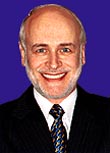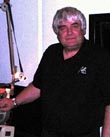|
|
 
|
|
Author
|
Topic: Dolby,level
|
|
|
|
|
|
|
|
|
|
|
John F. Allen
Film Handler

Posts: 54
From: Newton, MA
Registered: Nov 1999
|
 posted 01-09-2000 02:25 PM
posted 01-09-2000 02:25 PM




There is a great deal of confusion about the reasons that faders must be run typically at 5 1/2 and as low as 3 1/2, for the program levels in the theatres to be normal. If a fader is indeed running at 5 1/2, it means that the accumulated errors in the technician's measurement system and the techniques used for system setup totaled about 5 dB. In other words, when 85 dB was measured on an SPL meter, it was equivalent to 91 dB. This is hard for some to understand, but it is the case nonetheless. Since it is impossible to wave a magic wand and provide the technicians with the measuring equipment, training and speaker systems needed for everything to come out the way it should, allowing faders to be set at "7" for both calibration and operation, I recommend the following: If one finds after calibration done with the fader at "7" that a fader must be set at (say) 5 1/2 for films (not trailers) to play at their correct level, simply reset the levels with the fader set at 8 1/2. Then films will run at "7" and in fact the system will be calibrated correctly, at least as far as levels are concerned. This reasons for all this are described in detail in an article that can be downloaded at:
http://www.hps4000.com/pages/special/missing.pdf John F. Allen
| IP: Logged
|
|
Steve Guttag
We forgot the crackers Gromit!!!

Posts: 12814
From: Annapolis, MD
Registered: Dec 1999
|
 posted 01-09-2000 04:18 PM
posted 01-09-2000 04:18 PM




Welcome John!Depending on the room, I will set it to SPEC, that is 85dbC at "7". These are for review rooms or premier situations where the deaf studio people will expect that "7" means what they are used to. For the rest of us... I try to get the comfortable setting to end up being "7" and this depends on the theatre and customer. Some customers like it quite while others like it loud. I find out where they think it sounds right and make that "7". This is normally about 78-80dBc. The problem with having the fader at 3.5 - 5.5 as the norm (as most are) is that it is VERY sensitive in that region. At "7" a little adjustment is still a little adjustment. Steve ------------------
"Old projectionists never die, they just changeover!"
| IP: Logged
|
|
|
|
|
|
Brad Miller
Administrator

Posts: 17775
From: Plano, TX (36.2 miles NW of Rockwall)
Registered: May 99
|
 posted 01-09-2000 10:24 PM
posted 01-09-2000 10:24 PM




In the simplest form, it is quite entirely possible the SPL meter the tech is using is not accurate. Personally, I prefer to stay towards the middle mark of the needle (analog meter) as it is the most accurate for channel balancing. This can easily be accomplished by setting the fader to 8 1/2 and calibrating for 90db. I'm sure if a thread on SPL meters was started it would be filled with everyone's pros and cons over the different units available, but in my opinion it all boils down to two things.
#1 is the equalization. Many techs tend to "over-eq" their auditoriums. I find this extremely common with SDDS units and Dolby CP-500s because somewhere, someone said "this eq is all digital so one frequency will not affect the adjacent"...which is bullshit. The end result of such thinking is one frequency is up and the next slider is down and up and down and up and down..."but just look at the RTA!!! It's perfect" they say. Well, it may look "perfect" on the RTA, but big deal. It sounds like pooh in the theater!
I am a big believer in cutting when needed and ONLY boosting when absolutely necessary. Even after eqing, the cards should be visually inspected for any obvious flaws (such as one or two frequencies high next to a few turned down low) and corrected. Also, for everyone who rolls off the low end on the stage speakers below 80hz "because that's the subwoofer's job", just listen to that great shrieky sound that always accompanies such thinking. The ears need the low frequencies to increase the sound pressure in the room to be able to "shield" themselves from the ear splitting upper frequencies (typically 4-8K) if played loud...much like the iris of the eyes "closes down" to protect itself from bright sunlight. Sound shouldn't hurt to listen to, but at the same time should have the capability to be powerful enough to shake the viewers.
Also of importance here is the size of the auditorium. Just because that RTA shows a perfect reference "X" curve doesn't mean anything. In very large rooms and very small rooms the rolloff angle MUST be fine adjusted by ear. (If anyone knows of a mathematical way to do this, then please post it here.)
| IP: Logged
|
|
|
|
|
|
|
|
|
|
All times are Central (GMT -6:00)
|
|
Powered by Infopop Corporation
UBB.classicTM
6.3.1.2
The Film-Tech Forums are designed for various members related to the cinema industry to express their opinions, viewpoints and testimonials on various products, services and events based upon speculation, personal knowledge and factual information through use, therefore all views represented here allow no liability upon the publishers of this web site and the owners of said views assume no liability for any ill will resulting from these postings. The posts made here are for educational as well as entertainment purposes and as such anyone viewing this portion of the website must accept these views as statements of the author of that opinion
and agrees to release the authors from any and all liability.
|

 Home
Home
 Products
Products
 Store
Store
 Forum
Forum
 Warehouse
Warehouse
 Contact Us
Contact Us




 Printer-friendly view of this topic
Printer-friendly view of this topic











 . I like to give those SR tracks a little kick!
. I like to give those SR tracks a little kick!



